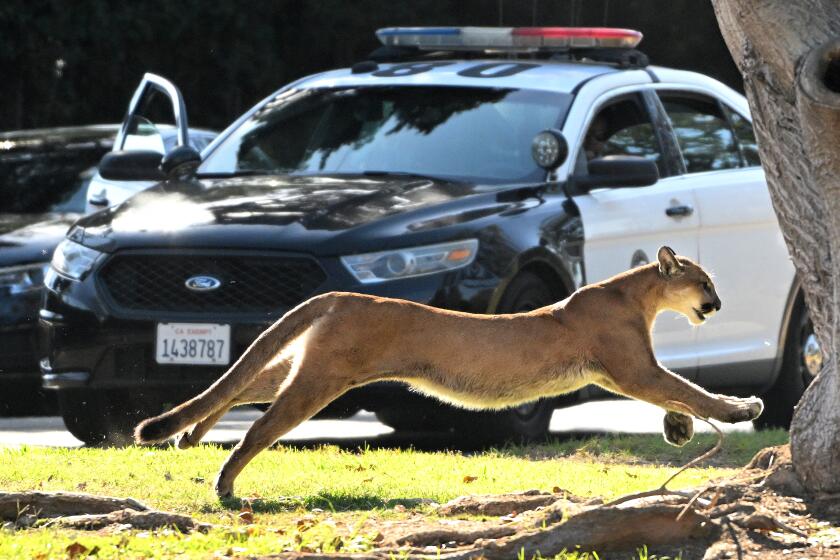Boiling Point: California’s fossil fuel crackdown continues — with some exceptions
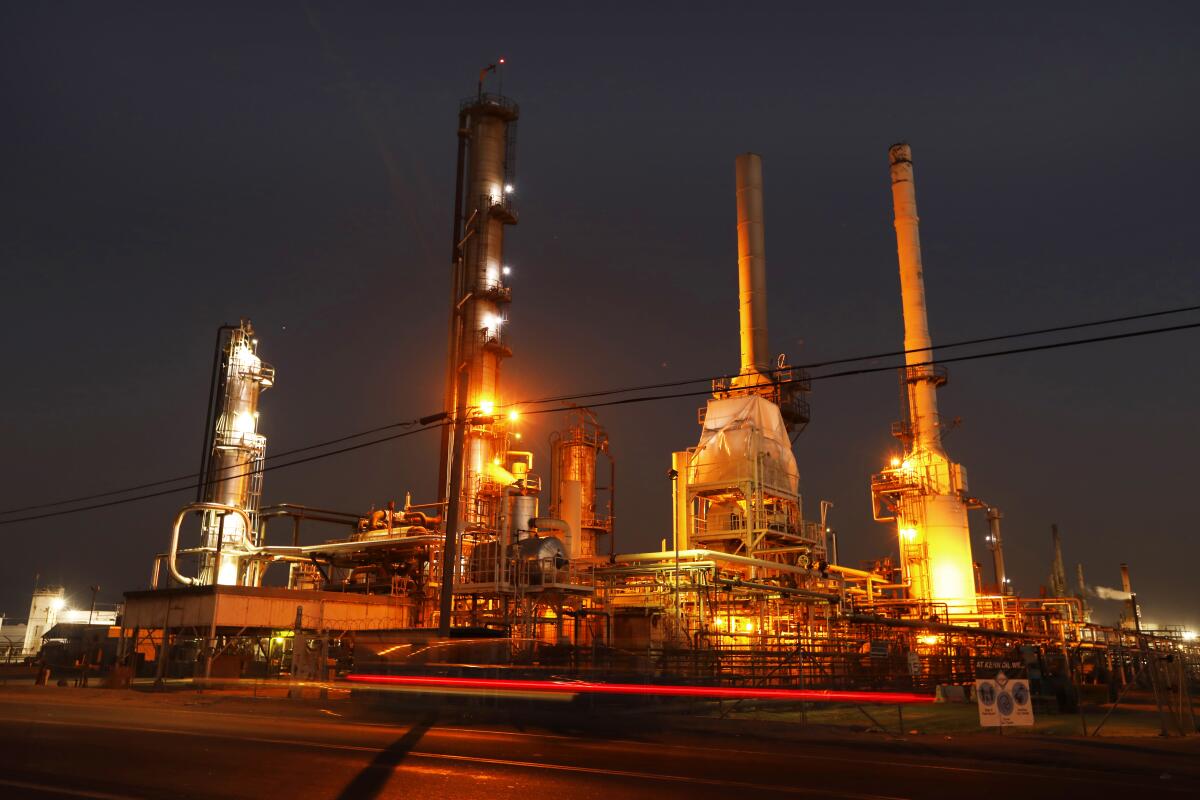
- Share via
In last Tuesday’s newsletter, I summed up some of the bills California Gov. Gavin Newsom had signed — and vetoed — dealing with climate change, energy and the environment.
I also promised a second legislative roundup.
Without further ado, the latest from Sacramento:
Buses, bikes and automobiles
There’s no bigger source of climate pollution in California and across the country than transportation. Some of California’s newest laws should help — and some of the bills vetoed by Newsom might have too.
You're reading Boiling Point
Sammy Roth gets you up to speed on climate change, energy and the environment. Sign up to get it in your inbox twice a week.
You may occasionally receive promotional content from the Los Angeles Times.
In good news for electric cars, the governor signed the Powering Up Californians Act, which aims to get homes and businesses hooked up to the electric grid faster and make it easier for them to ditch fossil-fueled cars and appliances. Newsom also signed off on Assembly Bill 579, which will require all new school buses to be zero-emission (most likely electric) starting in 2035.
Then there’s Assembly Bill 126, a major spending package that will devote more than $1 billion to clean transportation over the next dozen years — including, controversially, hydrogen fueling stations. (More on hydrogen in Thursday’s Boiling Point.)
Although clean cars and trucks are one important climate solution, driving less is another. The more we embrace public transit, biking and walking, the easier it will be to ratchet down our dependence on oil — and the fewer people will die in car crashes.
On this front, the governor’s actions were more of a mixed bag.
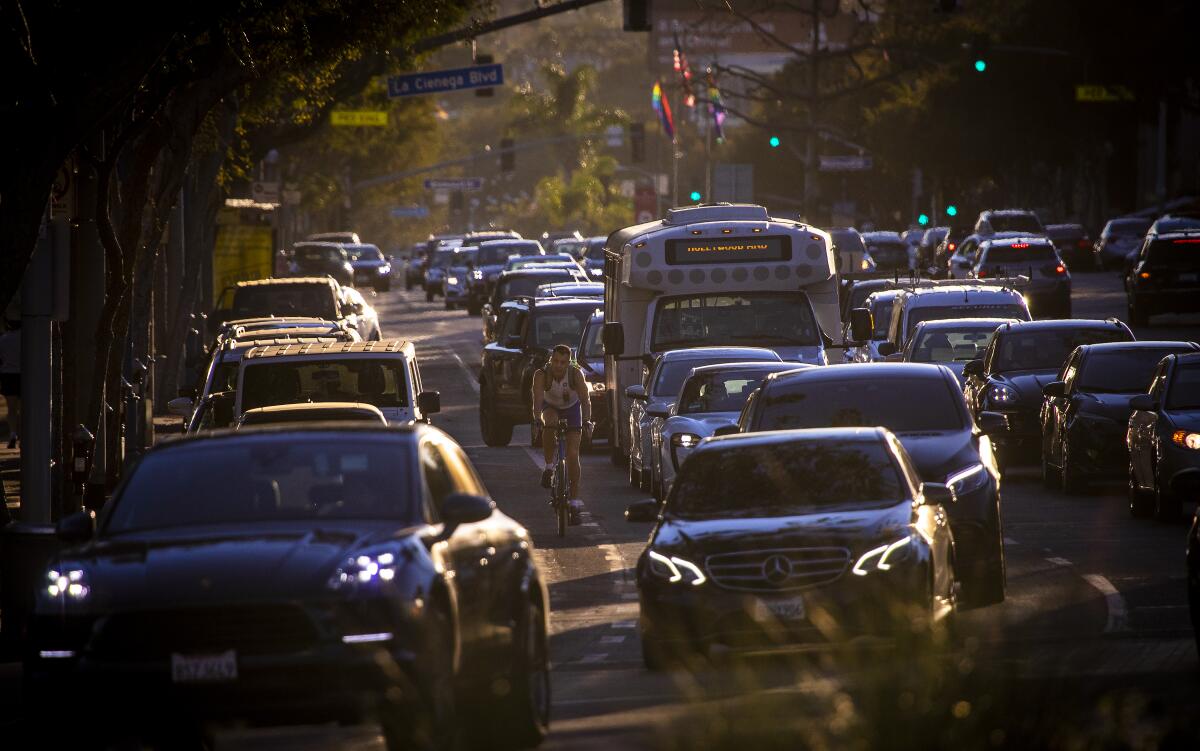
As the California Bicycle Coalition noted in a series of news releases, Newsom signed the the Deadly Oversized Cars Bill, which will require state officials to study the relationship between vehicle weight and road injuries and consider a fee on heavier cars.
The governor also signed Senate Bill 695, requiring the California Department of Transportation to release more information about highway projects — a transparency measure that supporters say is especially important in light of the recent demotion of a Caltrans executive who accused the agency of illicit freeway-widening, as my L.A. Times colleague Rachel Uranga reports.
At the same time, Newsom vetoed a bill that would have forced cities to allow biking on sidewalks next to roads without bikes lanes, writing in a veto message that most sidewalks “are not designed for bicyclists to safely use them, and riding on sidewalks would significantly increase the risk of collisions with pedestrians.” The bicycle coalition said that although it agreed with Newsom on the need for better bike infrastructure, his veto would lead to more injuries and deaths by forcing cyclists into traffic.
The governor also rejected legislation that would have decriminalized fare evasion on public transit. The bicycle coalition argued that misdemeanor charges for not paying the bus or train fare “can result in a criminal record, adding to a cycle of poverty and underemployment.” Newsom was unconvinced, writing that unpaid fares cost transit agencies across the state tens of millions of dollars each year and suggesting that reducing penalties for fare evasion could lead to more crimes on transit.
On a final note, Newsom signed Assembly Bill 1633, which supporters say will make it harder for city governments to use the California Environmental Quality Act to delay approval of dense, infill housing projects in urban areas. That’s relevant to climate change and transportation because the less our cities continue to sprawl, the fewer miles we’ll need to drive.
Teach your children well
A new law written by Assemblymember Luz Rivas (D-North Hollywood) will require California public schools to include climate change in their science curricula for elementary and high school students. That’s crucial for our collective future.
Although Newsom signed that law, he also vetoed Senate Bill 394 from Sen. Lena Gonzalez (D-Long Beach), which would have required state officials to develop a master plan for school districts to embrace sustainability and climate resilience.
I wrote earlier this year about the value of school campuses that generate clean power and protect students from heat, wildfire smoke and other climate dangers. Newsom acknowledged the value of those steps but complained that Gonzalez’s bill “will cost up to $10 million that was not considered through the annual budget process.”
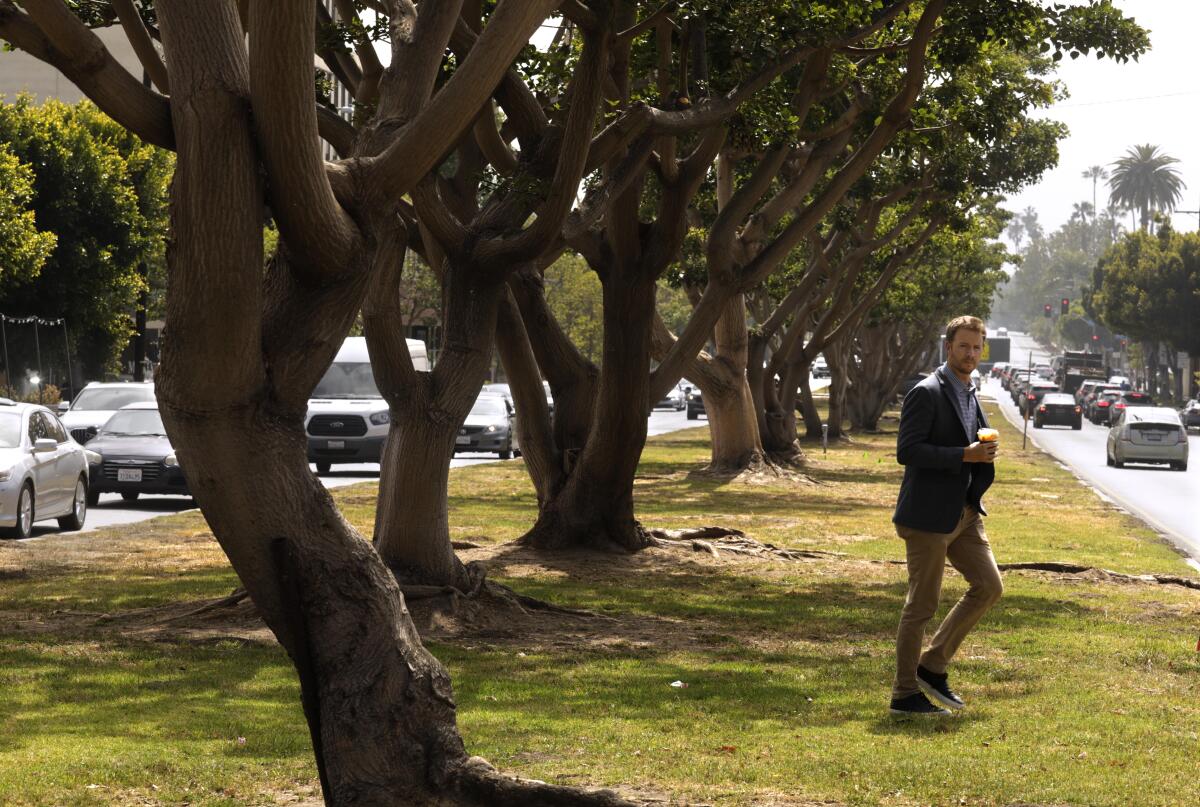
Water, water rights everywhere
If you’re tired of looking at thirsty expanses of green grass that no one uses, you’re in luck. Newsom signed Assembly Bill 1572, which, as my colleague Ian James explained last month, bans the use of drinking water to irrigate purely decorative grass. The governor also approved Senate Bill 676, which, as Ian wrote, will allow cities to ban the installation of artificial turf at homes, based on research showing that fake grass can result in microplastics washing into streams and the ocean.
But farmers are by far the state’s largest water users — and lawmakers were more hesitant to strike at their consumption.
This San Francisco Chronicle headline sums it up: “New California law takes aim at injustices in water rights system, but barely.” Although Newsom signed Senate Bill 389 — which will make it easier for regulators to investigate the validity of some of the state’s oldest and largest water rights — lawmakers didn’t approve bills that would have given those regulators broader author to crack down on water rights holders with cutbacks and fines, as Chronicle reporter Kurtis Alexander notes.
Newsom did sign Assembly Bill 779, which will “level the playing field for all groundwater users, particularly small farmers and farmers of color,” according to three UCLA law students who helped write the bill. The governor also approved legislation that will require state officials to develop new recommendations for recharging the state’s over-pumped underground aquifers.
In a win for the migrant farmworker town of Pajaro on the Central Coast, Newsom signed Assembly Bill 876, which, as The Times’ Susanne Rust noted, would protect the town from floods by speeding up fixes to a levee that failed during spring storms.
But in a blow to disadvantaged communities statewide, the governor vetoed legislation that would have tightened standards for lead testing in schools’ drinking water, writing that the bill “requires the creation of a costly database for tracking compliance and enforcement, and contains an infeasible implementation timeline.”
They call it liquid gold
First off, huge kudos to Desert Sun environment reporter Janet Wilson — who joined the Coachella Valley newspaper just as I was leaving — for inspiring a new law, just signed by Newsom, with her reporting on the utter lack of enforcement by an agency that’s supposed to penalize oil companies for spills. The law “increases penalties to as much as $70,000, and gives state regulators new abilities to request criminal enforcement against oil companies who fail to follow the law,” Janet writes.
Newsom also pleased environmental activists by vetoing Senate Bill 842 from Sen. Steven Bradford (D-Gardena), which critics said would have undermined last year’s law designed to penalize any oil companies found to be price-gouging at the pump. Newsom wrote in his veto message that the bill “could create a barrier to the [California Energy Commission’s] ability to protect consumers from unnecessary gasoline price spikes caused by interruptions in petroleum supply.”

Last but not least
I won’t pretend to have summarized every new law that will affect climate change or the environment — there are dozens more, and I’ve only got so much time. But here are a few final items that caught my attention:
- Newsom signed Senate Bill 272, which will require coastal counties to prepare plans for sea level rise — although not until 2034. As L.A. Times coastal reporter Rosanna Xia writes in her new book, “California Against the Sea” — and as we discussed in a Q&A last month — Newsom has previously vetoed more aggressive legislation for responding to rising ocean waters.
- The governor also signed a bill meant to limit the dangers of lithium-ion battery fires by requiring battery operators to adopt safety and communications measures. Batteries are crucial to replacing fossil fuels by storing solar and wind power for times when the sun isn’t shining and the wind isn’t blowing — but they’re also prone to occasionally catch fire, as the San Diego Union-Tribune’s Rob Nikolewski notes in a story exploring whether we should be worried.
- A bill from Assemblymember Eduardo Garcia (D-Coachella) would have created a program to prioritize local hiring for lithium extraction and geothermal energy projects at the southern end of the Salton Sea — a priority for Imperial County officials and environmental justice activists who want to make sure the expected clean energy boom benefits locals. But Newsom rejected the bill, writing that its provisions “are duplicative of work already underway.”
- If you’ve had trouble reserving a campsite at a California state park or beach, Assembly Bill 618 may be for you. The newly signed legislation “seeks to improve access by discouraging residents from reserving campsites they do not plan to use or canceling their reservations at the last minute,” my colleague Jeremy Childs writes. In other good news from campers, the governor signed a bill designed to end the use of dangerous flame-retardant chemicals in tents.
- If you think California needs to do more to reduce plastic pollution, you’re out of luck. As Waste Dive’s Megan Quinn reports, Newsom vetoed bills that would have banned plastic gift cards, required grocery stores to allow customers to return reusable bags and created a working group to evaluate alternatives to single-use plastics. The governor argued that some of the proposed bills would have been too burdensome on businesses, and others would have been duplicative of existing efforts.
**
And now, here’s what’s happening around the West:
TOP STORIES
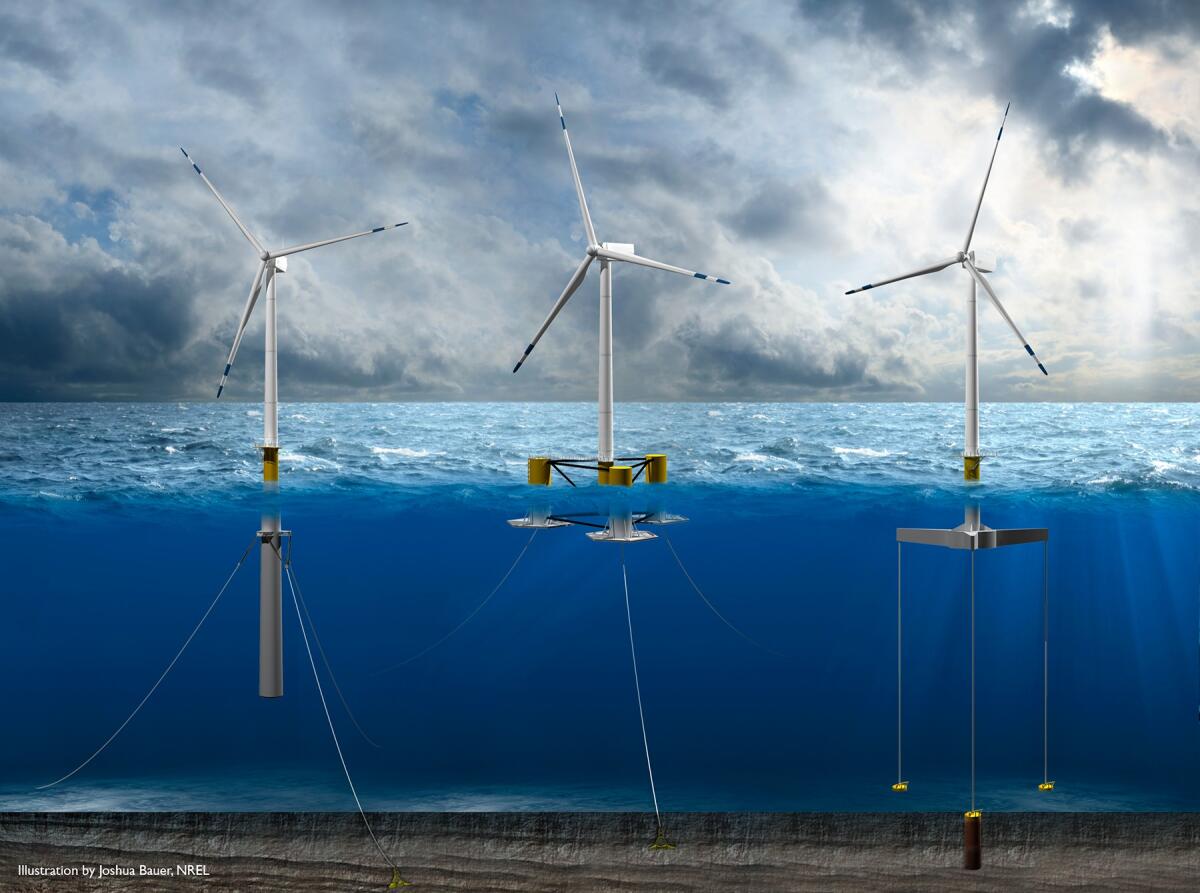
Even with a new law that could see California purchase large amounts of offshore wind power, the wind industry faces a long list of economic, technical and environmental challenges as companies seek to prop up their first turbines off the California coast. CalMatters’ Julie Cart has a fabulous in-depth story exploring those challenges, as well as a second piece that takes a closer look at Central Coast residents fighting to block offshore wind, which they fear will industrialize their precious shoreline.
Groundwater levels are on the rise in parts of California after an exceptionally wet year — but most of the state still faces a challenging long-term outlook. My colleague Ian James has the details, reporting that from spring 2022 to spring 2023, water levels rose significantly in 34% of wells studied by the California Department of Water Resources. In Nevada, meanwhile, officials have an intriguing new strategy for getting aquifers and rivers into better shape. The state plans to dole out $25 million in federal funds to buy water rights from farmers, the Nevada Independent’s Daniel Rothberg reports.
Lest anyone fool themselves into thinking that the United States is doing nearly enough on climate change, the nation produced more oil than ever during the first week of October. Here are the numbers, courtesy of the Associated Press’ Seth Borenstein. And in case anyone is still wondering what kind of future oil and gas giant Exxon Mobil is planning for, the company plans to buy fellow fossil fuel driller Pioneer Natural Resources for roughly $60 billion, the AP’s Michelle Chapman reports.
WATER IN THE WEST

Environmentalists are turning a rugged stretch of California coast into a lab for conservation. So writes The Times’ Louis Sahagún about Point Conception and the larger Gaviota Coast, describing a dam removal and other projects designed to “restore this region of rolling hills, twisted oaks, brackish lagoons and shale cliffs overlooking wind-whipped sandy beaches to its original state.” Be sure to check out the gorgeous photos of beaches, birds and butterflies by Allen J. Schaben.
Government biologists are rounding up spring-run chinook salmon from Sacramento River tributaries, to preserve their genetic lineage in case they go extinct in the wild. It’s a desperate measure — but these are desperate times for California’s aquatic ecosystems, The Times’ Ian James reports, as climate change dries up rivers and humans suck more water out of them than nature can handle. In a related story in Washington state, tribes are rejoicing as salmon return to the Elwha River, a decade after several dams came down, Lynda V. Mapes writes for the Seattle Times. It’s an example of how rivers can benefit when dams are torn down — a topic I recently wrote about in great detail.
Artist Lauren Bon is the first person to obtain a permit to divert water from the Los Angeles River in more than a century. She’ll use that water to irrigate nearby Los Angeles State Historic Park, my colleague Carolina A. Miranda writes, in a cool example of the reimagining taking place along parts of the concrete-encased river. “When we have no connection to the story of water and this place where we live, how do we connect the place to water?” Bon asks.
THE ENERGY TRANSITION
California will get up to $1.2 billion in federal funds for hydrogen energy projects, the Biden administration announced last week — but some climate activists are skeptical about the technology’s value. My colleague Hayley Smith wrote about the money, and what it might be used for (which is still something of an unknown). I reported last year on the pros and cons of hydrogen, and will have more reporting on the new federal funds in Thursday’s Boiling Point newsletter.
Nothing crazy happened on California’s electric grid during Saturday’s solar eclipse — but the state’s main grid operator still expected it to be a valuable learning experience as we depend more on the sun for our electricity. Politico’s reporting team had some observations ahead of the eclipse. In related news, California set another solar energy record last month — three weeks after the previous one, S&P Global’s Kassia Micek reports. Inside Climate News’ Dan Gearino, meanwhile, wrote about new research debunking widely repeated claims that solar panels contain dangerous amounts of hazardous chemicals.
The Colorado city of Pueblo has a legitimate case that it’s at the center of the global energy transition. So should we be worried that a bunch of clean energy manufacturing hasn’t led to boom times for the coal town? That’s the question at the center of this fascinating story by Chase Woodruff for Colorado Newsline. “If the green economy is turning things around for Pueblo as a whole, it isn’t easy to see it in the pocketbooks of people around town,” Woodruff writes. “Incomes here are roughly 30% lower than the statewide average, a gap that hasn’t narrowed over the last decade. Population growth remains slow, and local tax revenues are mostly flat.”
WESTERN WILDLIFE

A new study finds a link between bird species diversity and a history of racist real estate practices — known as redlining — in Los Angeles County. Whiter, wealthier neighborhoods tend to have more avian species than lower-income communities of color with fewer trees and less vegetation cover, The Times’ Dorany Pineda reports. It’s eye-opening to learn how many ways the nation’s discriminatory history can continue to affect our environment and health — an area I delved into earlier this year, writing about research showing a link between where freeways were built in L.A. County and who is breathing dirty air today.
Is climate change to blame for fewer spiders? We don’t yet know for sure, but my colleague Susanne Rust took a look, hanging out with naturalists and tarantulas at Mt. Diablo State Park. Be sure to check out the close-up tarantula photos.
A conservation group is planning another lawsuit to try to block Nevada’s Thacker Pass lithium mine, saying the mine could harm a tiny snail. Details here from the Associated Press’ Scott Sonner — and yes, this is the umpteenth example of conservation activists sparring with energy and mining companies, whose projects are needed to confront the climate crisis but can nonetheless result in environmental harm, a topic I’ve been exploring through the ongoing Repowering the West series. In California’s Inyo Mountains, meanwhile, state officials have just protected a rare flower, The Times’ Louis Sahagún reports — a move that could derail a planned mine (although it’s a gold mine, not super relevant to the clean energy transition).
UTILITY CLIMATE
California has three major monopoly utility companies: Southern California Edison, Pacific Gas & Electric and San Diego Gas & Electric (the latter is a subsidiary of Sempra Energy). Three stories to share, one about each investor-owned utility:
- SoCal Edison and the federal government have agreed to a tentative settlement over the deadly 2017 Thomas fire, which investigators have found was ignited by the company’s power lines. (Story by Joyce E. Cutler, Bloomberg)
- California officials have proposed a $45-million penalty for PG&E for igniting the state’s second-largest blaze, the Dixie fire. Most of the money would be spent transitioning the company’s records to an electronic format. (Reuters)
- A lawsuit challenging San Diego’s franchise agreements with SDG&E has been largely dismissed, clearing the way for the company to keep serving as the electricity and gas provider for the city. (Rob Nikolewski, San Diego Union-Tribune)
ONE MORE THING

I am far from an expert in famed desert writer and conservationist Edward Abbey, author of “Desert Solitaire” and “The Monkey Wrench Gang.” But having read both of those books, I was plenty familiar enough with Abbey’s views — anti-development, pro-wilderness, generally fed up with the capitalist economic engine tearing up precious landscapes and damming rivers — to know how poorly he’d react to an Edward Abbey-themed subdivision currently being built in Moab, Utah.
“Ed would spin many times in his grave,” a longtime friend of Abbey’s told the Durango Telegraph’s Jonathan Romeo.
“Jesus Christ,” another Abbey friend said. “That’s a goddamn shame.”
Somehow, there’s still irony in the world in 2023.
We’ll be back in your inbox Thursday. To view this newsletter in your Web browser, click here. And for more climate and environment news, follow @Sammy_Roth on Twitter.
Toward a more sustainable California
Get Boiling Point, our newsletter exploring climate change, energy and the environment, and become part of the conversation — and the solution.
You may occasionally receive promotional content from the Los Angeles Times.

